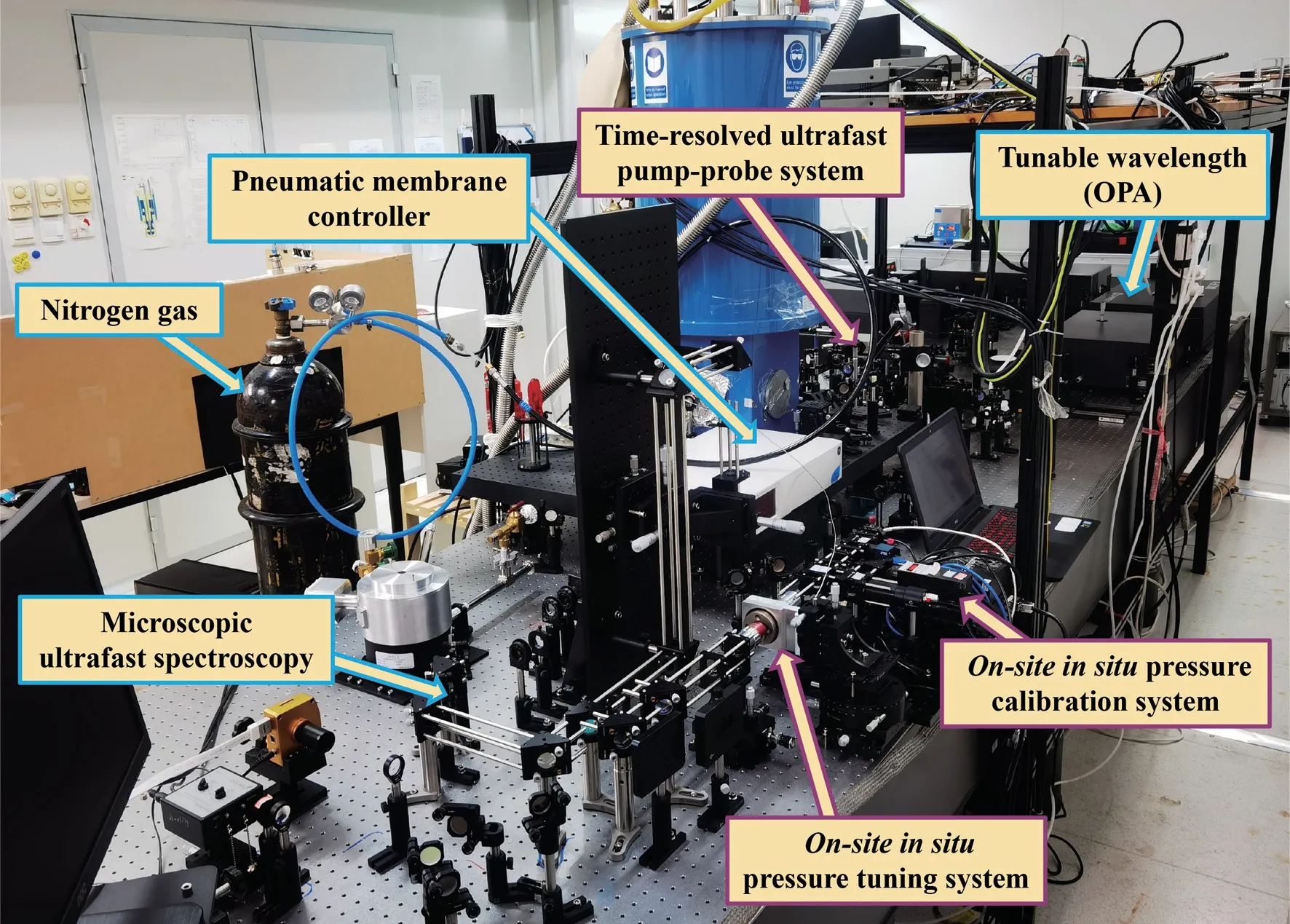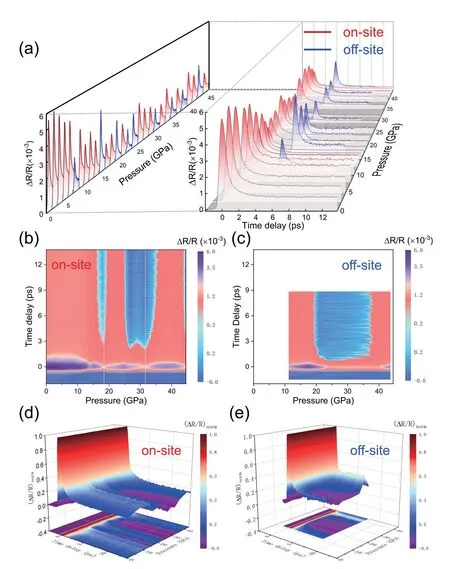Scientists Innovate On-site in situ High-Pressure Ultrafast Pump-Probe Spectroscopy Instrument
Time-resolved ultrafast spectroscopy has been widely employed in condensed matter physics (and other sciences) due to its unique advantages, such as ultrahigh temporal resolution, capability of detecting excited-states above the Fermi surface, and generation of coherent boson excitations. It has been extensively used to investigate various condensed matter physics, including high-temperature superconductivity, complex phase transition, coupling between different degrees of freedom, coherent control, laser-induced novel quantum states and hidden states,etc. High pressure technique has also been widely employed in condensed matter physics (and other scientific areas), owing to its unique capability of tuning the electronic band structure by directly modifying the lattice constants. In recent years, efforts have been devoted to combining the two areas together, driven by the rich and deep fundamental scientific demands aforementioned to probe ultrafast dynamics under high pressure [Chin. Phys. Lett. (Express Letter) 37, 047801 (2020)].
Challenges mainly come from the data reliability. Because ultrafast dynamics investigations are very delicate experiments and high pressure also causes rich complex physical effects, maintaining reliable data is very crucial for correct understanding of the mechanism, and also for the initiation and development of such a cross-field direction - high pressure ultrafast dynamics. Conventionally, when tuning and calibrating the high pressure, the diamond anvil cell (with a sample enclosed) is often taken outside the light path and later put back. During such processes, sample motion or rotation relative to the light beam can be introduced. Such repositioning artifacts introduced are worse for two-incident-beam experiments (e.g. pumpprobe ultrafast spectroscopy) under high pressure conditions. In practice, a few worldwide preliminary attempts mostly report on the lifetimes of the quasiparticles, rather than providing precise information on the amplitudes, which presents obstacles in fully understanding the ultrafast dynamics and mechanisms. For example, one of the key signatures of the quantum properties of superconducting phase transition, charge density wave ordering formation and topological phase transition is that there is an energy gap opening or closing. This variation in energy gap directly corresponds to the phonon-bottleneck effect in the excited state ultrafast spectroscopy experiments. Experimentally, verification of the phonon bottleneck effect needs full information on both the amplitude and the lifetime. Lifetime information alone is not adequate to identify it. Therefore, simultaneously obtaining reliable amplitude and lifetime is critical for the development of the crossfield high-pressure ultrafast dynamics.
Two pivotal requirements for the instrument innovation thus follow: (1) Technology aspect - innovate a reliable and accurateon-site in situhighpressure ultrafast pump-probe spectroscopy instrument. (2) Standard aspect - initiate a standard description for such investigations and experiments. Colleagues are invited to explicitly state whether their experiments areon-site in situor not, so that the reported experimental data are comparable with each other without systematic errors. Following the standard description, the reliability and accuracy of the data in the community are greatly enhanced and potential artifacts or even misleading understanding will be prominently reduced.
Recently, Professor ZHAO Jimin and Dr. WU Yanling, a postdoctoral researcher with him, and Jiazila Hasaien and TIAN Zhenyun, both PhD students at the Beijing National Laboratory for Condensed Matter Physics, Institute of Physics (IOP) under the Chinese Academy of Sciences (CAS), collaborate with Professor DING Yang and his PhD student YIN Xia at the Center for High Pressure Science and Technology Advanced Research to develop anon-site in situhigh pressure ultrafast pump-probe spectroscopy instrument at room temperature (TOC Figure and Figure 1). Its construction has achieved essential breakthroughs: (1) In technical aspect, they realized theon-site in situtechnology. Both the sample and the diamond anvil cell are fixed in the light path during the whole ultrafast pumpprobe experiment, especially including tuning and calibrating the high pressure, to avoid the repositioning fluctuation (Figure 2). The sample motion and rotation are removed to the maximum possible extent (within the fluctuation range using the CCD monitoring and fine-adjustment system). Thus, unnecessary artifacts are avoided during the experiment and the precision and reliability of the experimental data are maximized. (2) In standard aspect, they proposed anon-site in situstandard description. Comparison between the results underon-site in situandoff-site in situconditions is shown in Figure 3. By explicitly describing whether the DAC is removed out and put back into the light path, the comparability, compatibility, and consistency of the experimental data can be greatly improved within the academic community (Figure 3). With this standard description, unnecessary systematic comparison error and interpretation deviation is avoided to the maximum extent (note that in synchrotron beamline experiments, precise kinematic mounts are routinely employed, and thus, the experimental conditions are also guaranteed to be equivalent toon-site in situconditions). In summary, based on the above two aspects of instrument innovation and breakthrough, the research team obtained at ambient temperature both reliable amplitudes and lifetimes of the ultrafast dynamics, thus providing rich and comprehensive information. Their work provides a reliable means for obtaining the high pressure ultrafast dynamics of quantum materials and further understanding the complex phase transition and excited state dynamics induced or modified by high pressure.

Figure 1: The on-site in situ high-pressure time-resolved ultrafast pump-probe spectroscopy instrument. (Adapted from Rev. Sci. Instrum. 92, 113002 (2021).)

Figure 2: Drawbacks of sample motion or rotation on obtaining reliable ultrafast pump-probe data. (Adapted from Rev. Sci. Instrum. 92, 113002 (2021).)
This study entitled “On-site in situ high-pressure ultrafast pump-probe spectroscopy instrument” was published in Review of Scientific Instruments [Rev. Sci. Instrum. 92, 113002(2021)].
The study was supported by the National Key Research and Development Program of China, the National Natural Science Foundation of China, the Chinese Academy of Sciences Interdisciplinary Innovation Team, the International Partnership Program of CAS, the Strategic Priority Research Program of CAS, and the Beijing Natural Science Foundation.
Contact:
Institute of Physics
ZHAO Jimin
Email: jmzhao@iphy.ac.cn
(IOP)

Figure 3: Comparison of the experimental data of relative differential reflectivity ΔR/R between on-site in situ and off-site in situ conditions. (Adapted from Rev. Sci. Instrum. 92, 113002 (2021).)
 Bulletin of the Chinese Academy of Sciences2021年4期
Bulletin of the Chinese Academy of Sciences2021年4期
- Bulletin of the Chinese Academy of Sciences的其它文章
- Organic Molecule Remnants Found in the Nuclei of Ancient Dinosaur Cells
- Decoding Human History with Ancient DNA
- Research Discovers General Principle Organizing Phenotypically Diverse Bacteria during Collective Migration
- Buoy-borne Underwater Dark Field Imaging System Improves Marine Plankton Monitoring Capability
- Novel Fluorescent Hydrogel Developed to Achieve Soft Biomimetic Color-Changing Skins
- Imaging Atomic Structure of Hybrid Perovskite CH3NH3PbI3
